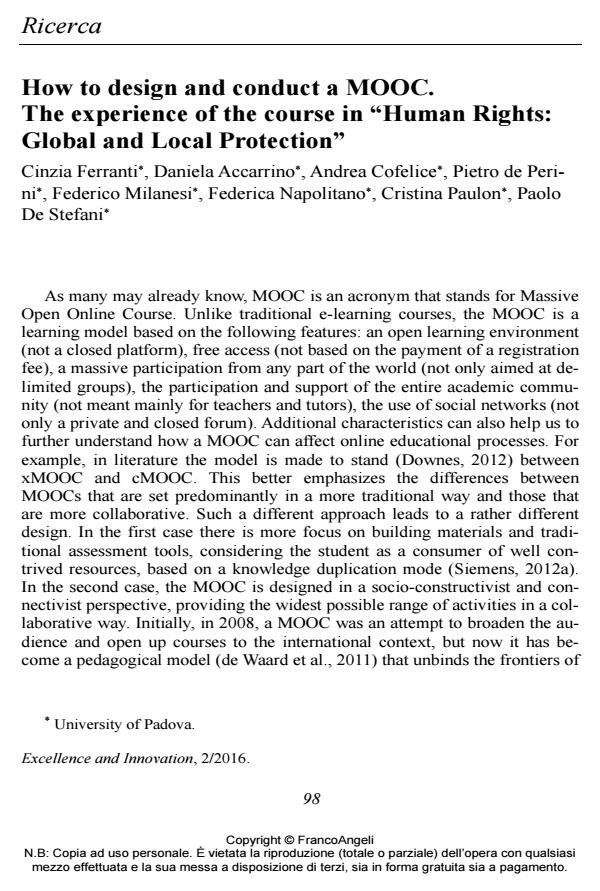How to design and conduct a MOOC. The experience of the course "Human Rights: Global and Local Protection"
Journal title EXCELLENCE AND INNOVATION IN LEARNING AND TEACHING
Author/s Cinzia Ferranti, Daniela Accarrino, Andrea Cofelice, Pietro de Perini, Federico Milanesi, Federica Napolitano, Cristina Paulon, Paolo De Stefani
Publishing Year 2016 Issue 2016/2
Language English Pages 17 P. 98-114 File size 238 KB
DOI 10.3280/EXI2016-002007
DOI is like a bar code for intellectual property: to have more infomation
click here
Below, you can see the article first page
If you want to buy this article in PDF format, you can do it, following the instructions to buy download credits

FrancoAngeli is member of Publishers International Linking Association, Inc (PILA), a not-for-profit association which run the CrossRef service enabling links to and from online scholarly content.
This article aims at illustrating how a Massive Open Online Course (MOOC) is produced and managed by narrating a unique enterprise in this field and, more specifically, by describing the role played by the different actors and centres of the University of Padova and of Iversity, the international host. This is basically the tale of our experience, i.e. the first MOOC proposed on the international scene. The entire process required the orchestration and organization of many activities and fields of expertise: knowledge organization and representation by the content provider, the instructional design process, the video production, the definition of assessment tools and methods, as well as content media management. Our intention of writing this article is to propose an account of our experience that could help other Higher Education Institutions to plan their own MOOCs in future.
Keywords: MOOC; higher education; learning design; learning management; human rights.
- How to play a MOOC: Practices and simulation Dario De Notaris, Sergio Canazza, Carlo Mariconda, Cristina Paulon, in Entertainment Computing 100395/2021 pp.100395
DOI: 10.1016/j.entcom.2020.100395
Cinzia Ferranti, Daniela Accarrino, Andrea Cofelice, Pietro de Perini, Federico Milanesi, Federica Napolitano, Cristina Paulon, Paolo De Stefani, How to design and conduct a MOOC. The experience of the course in "Human Rights: Global and Local Protection" in "EXCELLENCE AND INNOVATION IN LEARNING AND TEACHING" 2/2016, pp 98-114, DOI: 10.3280/EXI2016-002007